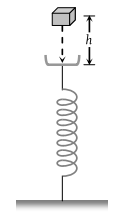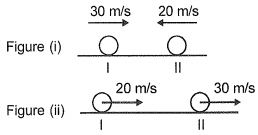A spring 40 mm long is stretched by the application of a force. If 10 N force required to stretch the spring through 1 mm, then work done in stretching the spring through 40 mm is
1. 84 J
2. 68 J
3. 23 J
4. 8 J
A particle is moving on the circular path of the radius (R) with centripetal acceleration ac=k2Rt2. Then the correct relation showing power (P) delivered by net force versus time (t) is

1. 1
2. 2
3. 3
4. 4
A body is displaced from (0,0) to (1m,1m) along the path x=y by a force F=(x2ˆj+yˆi)N. The work done by this force will be :
1. 43J
2. 56J
3. 32J
4. 75J
A weightless rod of length 2l carries two equal mass 'm', one tied at lower end A and the other at the middle of the rod at B. The rod can rotate in a vertical plane about a fixed horizontal axis passing through C. The rod is released from rest in the horizontal position. The speed of the mass B at the instant rod becomes vertical is:

1. √3gl5
2. √4gl5
3. √6gl5
4. √7gl5
As per the given figure to complete the circular loop, what should be the radius of the loop?
1. 4 m
2. 3 m
3. 2.5 m
4. 2 m
A force acts on a 30 gm particle in such a way that the position of the particle as a function of time is given by x=3t−4t2+t3, where x is in metres and t is in seconds. The work done during the first 4 seconds is
(1) 5.28 J
(2) 450 mJ
(3) 490 mJ
(4) 530 mJ
A particle moves in a straight line with retardation proportional to its displacement. Its loss of kinetic energy for any displacement x is proportional to-
(1) x2
(2) ex
(3) x
(4) loge x
A block of mass m initially at rest is dropped from a height h on to a spring of force constant k. The maximum compression in the spring is x then-
(1) mgh=12kx2
(2) mg(h+x)=12kx2
(3) mgh=12k(x+h)2
(4) mg(h+x)=12k(x+h)2
An open knife edge of mass 'm' is dropped from a height 'h' on a wooden floor. If the blade penetrates upto the depth 'd' into the wood, the average resistance offered by the wood to the knife edge is
(1) mg
(2) mg(1−hd)
(3) mg(1+hd)
(4) mg(1+hd)2
The force acting on a body moving along x-axis varies with the position of the particle as shown in the fig.
The body is in stable equilibrium at
1. x = x1
2. x = x2
3. both x1 and x2
4. neither x1 nor x2
A ball is thrown vertically downwards from a height of 20 m with an initial velocity v0. It collides with the ground, loses 50% of its energy in a collision and rebounds to the same height. The initial velocity v0 is: (Take g=10 m/s2)
1. 14 m/s
2. 20 m/s
3. 28 m/s
4. 10 m/s
The potential energy of a system increases if work is done
(1) by the system against a conservative force
(2) by the system against a nonconservative force
(3) upon the system by a conservative force
(4) upon the system by a nonconservative force
The points of maximum and minimum attraction in the curve between potential energy (U) and distance (r) of a diatomic molecules are respectively -
(1) S and R
(2) T and S
(3) R and S
(4) S and T
Two balls having different masses are moving towards each other with speed 30 m/s and 20 m/s as shown in figure (i). Their velocities after collision become 20 m/s and 30 m/s as shown in the figure (ii), then the coefficient of restitution is:
(1) 1
(2) 0.5
(3) 0.4
(4) 0.2
A smooth sphere of mass M moving with velocity u directly collides elastically with another sphere of mass m at rest. After collision, their final velocities are V and v respectively. The value of v is:-
1. 2uMm
2. 2umM
3. 2u1+mM
4. 2u1+Mm